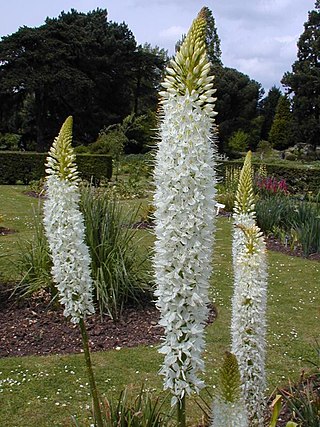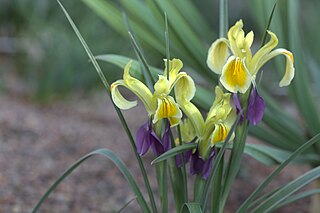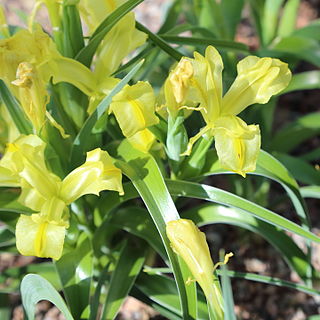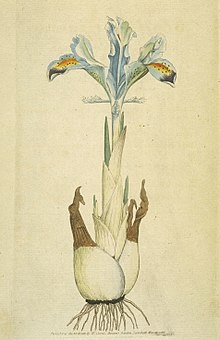
Onobrychis, the sainfoins, are a genus of Eurasian perennial herbaceous plants of the legume family (Fabaceae). Including doubtfully distinct species and provisionally accepted taxa, about 150 species are presently known. The Flora Europaea lists 23 species of Onobrychis; the main centre of diversity extends from Central Asia to Iran, with 56 species – 27 of which are endemic – in the latter country alone. O. viciifolia is naturalized throughout many countries in Europe and North America grasslands on calcareous soils.

Bellevalia is a genus of plants in the family Asparagaceae, subfamily Scilloideae. It was first described as a genus in 1808.

Eremurus is a genus of deciduous perennial flowers in the family Asphodelaceae. They are also known as the foxtail lilies or desert candles. They are native to eastern Europe in, and temperate Asia from Turkey to China.

Iris aucheri, the Aucher-Éloy iris, is a species of flowering plant in the family Iridaceae. It is a bulbous perennial in the Juno group of irises.

Hyacinthella is a genus of bulbous flowering plants in the family Asparagaceae, subfamily Scilloideae. It is native to eastern and south-eastern Europe through to northern Iran, reaching as far south as Palestine. Turkey is the main country in which species are found.

Iris reticulata var. bakeriana is a variety of Iris reticulata, a plant in the genus Iris. It is sometimes treated as Iris bakeriana, especially in the USA.

Subgenus Iris is one subgenus of Iris.

Iris caucasica is a species of plant in the genus Iris, it is also in the subgenus of Scorpiris. Pronounced as 'kaw-KAS-ee-kuh'.

Iris fosteriana is a species in the genus Iris, subgenus Scorpiris.
Iris nusairiensis is a species in the genus Iris, it is also in the subgenus Scorpiris. It is a bulbous perennial from Syria, it has pale blue or white flowers. It is cultivated as an ornamental plant in temperate regions.

Iris planifolia is a species of flowering plant in the subgenus Scorpiris of the genus Iris, family Iridaceae. This bulbous perennial from Southern Europe and North Africa has long, shiny green leaves, a short stem, and large scented flowers in various shades of blue.
Iris vicaria is a species in the genus Iris, it is also in the subgenus Scorpiris. It is a bulbous perennial from Asia, found in Tajikistan, Turkmenistan and Uzbekistan. It has tall arching leaves, and has varied coloured flowers, with white, blue and purple between April and May.
Iris zaprjagajevii is a species in the genus Iris, it is also in the subgenus Scorpiris. It is a bulbous perennial from Central Asia. It has greyish-green leaves, short stem and white flowers with a yellow crest.

Iris orchioides, the 'orchid iris,' is a plant species in the genus Iris, it is also in the subgenus Scorpiris. It is a bulbous perennial, from the mountains of Uzbekistan and Kyrgyzstan. It has dark green leaves, slender stems, up to three yellow flowers in spring. It is cultivated as an ornamental plant in temperate regions.

Iris maracandica is a species in the genus Iris, it is also in the subgenus Scorpiris. It is a bulbous perennial from Uzbekistan, Central Asia. It has short stems, scented spring flowers in shades of yellow.
Iris kuschakewiczii is a species in the genus Iris, it is also in the subgenus Scorpiris. It is a bulbous perennial, from the hills of Kazakhstan. It has dark green glaucous leaves, a short, thick stem, spring flowers in shades of purple.

Iris stenophylla is a species of flowering plant in the genus Iris, it is also in the subgenus Scorpiris. It is a bulbous perennial.
The precise taxonomy of the genus Allium is still poorly understood with incorrect descriptions being widespread. With over 850 species distributed over the Northern hemisphere Allium is the sole genus in the Allieae, one of four tribes of subfamily Allioideae (Amaryllidaceae). New species continue to be described and Allium is both highly variable and one of the largest monocotyledonous genera, but the precise taxonomy of Allium is poorly understood, with incorrect descriptions being widespread. The difficulties arise from the fact that the genus displays considerable polymorphism and has adapted to a wide variety of habitats. Furthermore, traditional classications had been based on homoplasious characteristics. However, the genus has been shown to be monophyletic, containing three major clades, although some proposed subgenera are not. Some progress is being made using molecular phylogenetic methods, and the internal transcribed spacer (ITS) region, including the 5.8S rDNA and the two spacers ITS1 and ITS2, is one of the more commonly used markers in the study of the differentiation of the Allium species.














